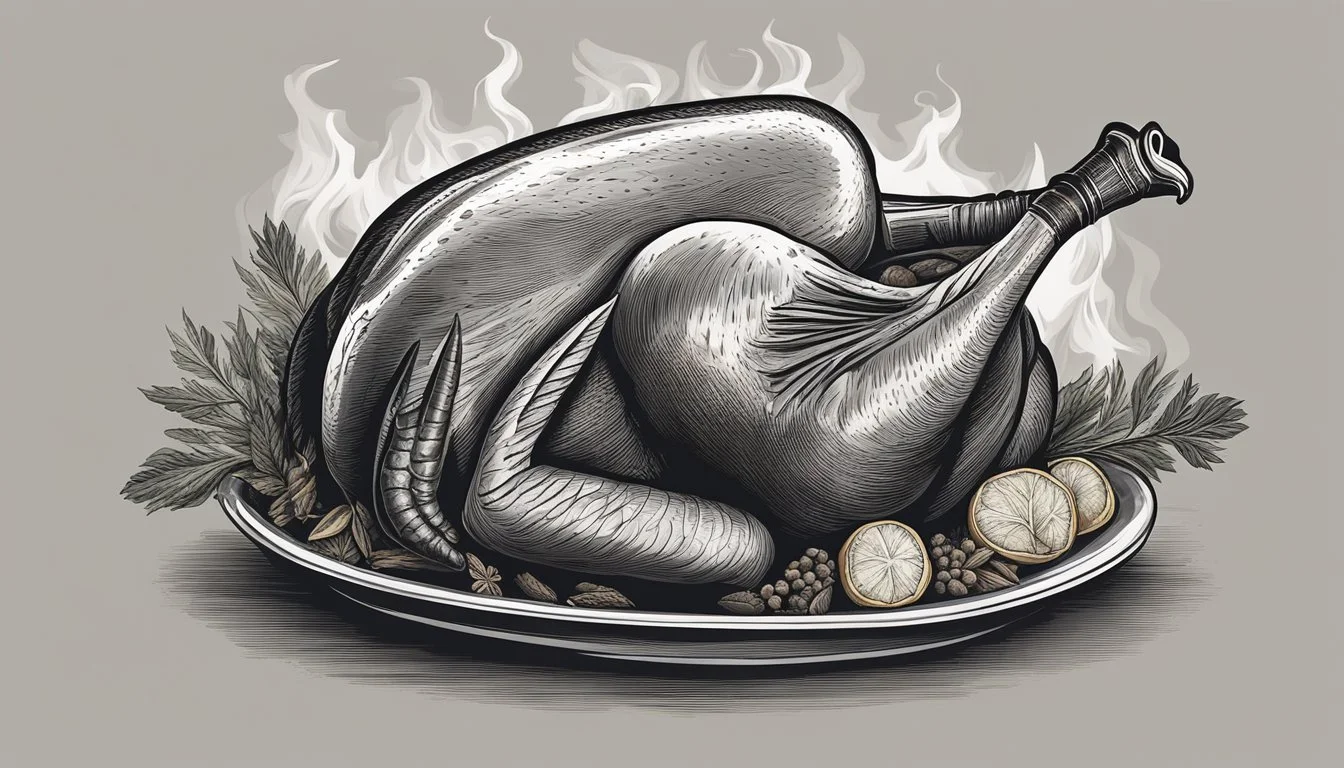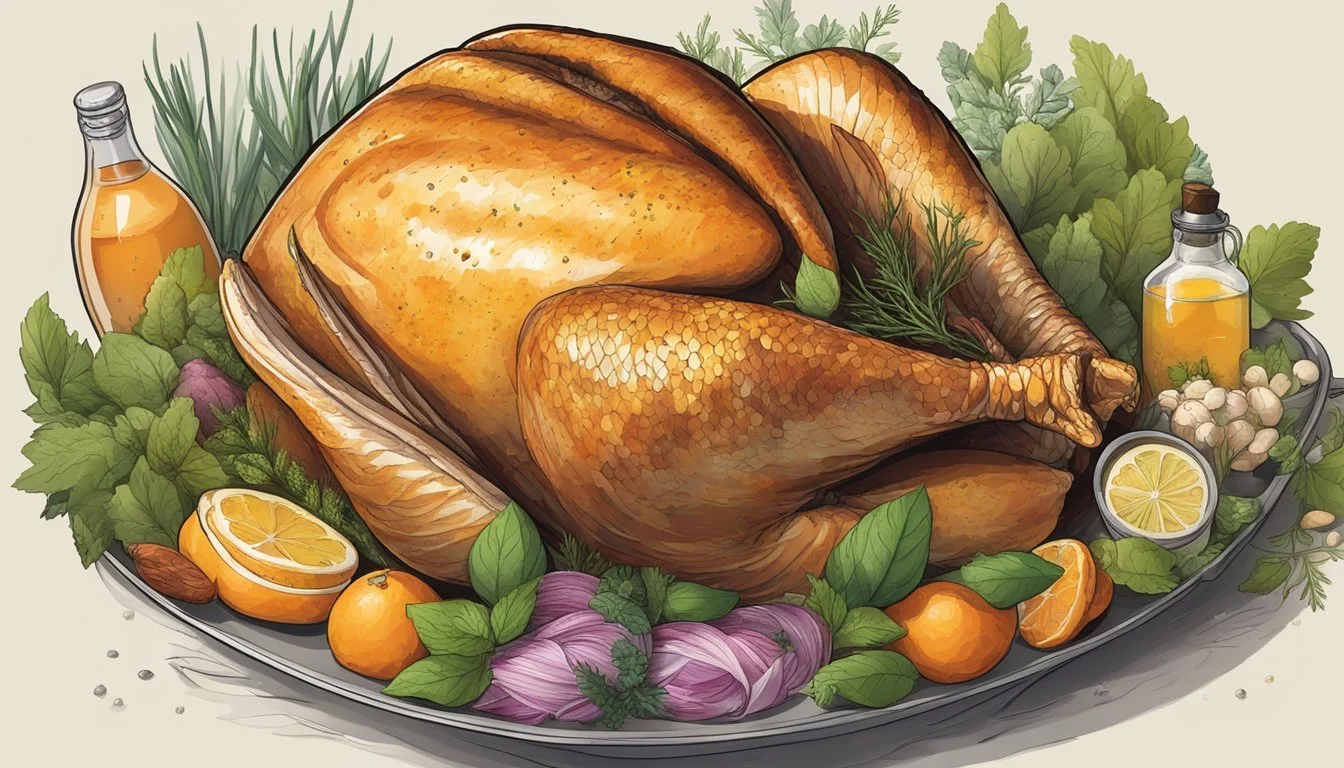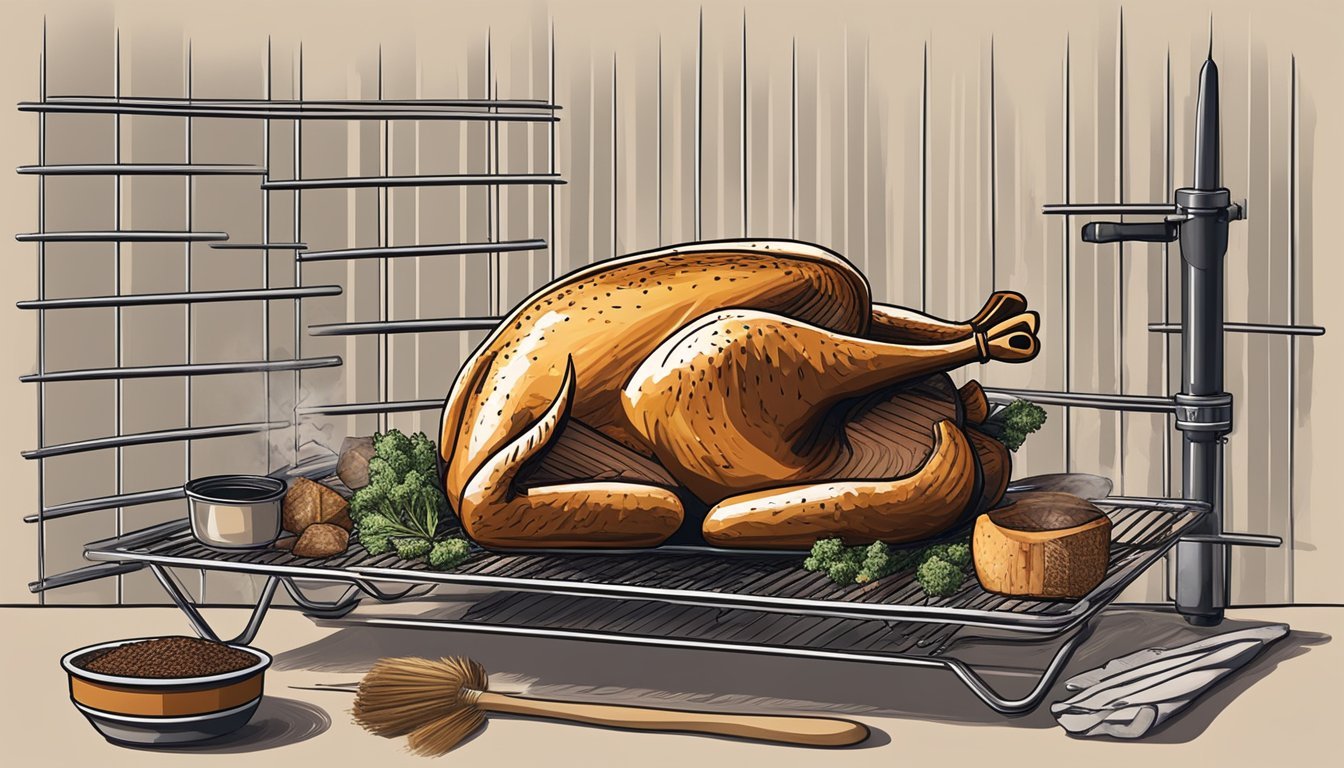How to Cook Texas-Style Smoked Turkey
Your Ultimate Guide
Embracing the Lone Star State's rich tradition of barbecuing, Texas-style smoked turkey has become a celebrated dish that showcases the art of slow cooking meat using indirect heat and smoke to infuse flavor. A break from the typical pork and beef heavy menus, this leaner alternative brings a different kind of succulence to the table. It combines the complex nuances of wood smoke—often from native woods like post oak—with a rub that highlights the robust flavors Texans adore.
When preparing a Texas-style smoked turkey (What wine goes well with turkey?), attention to detail is key. The process begins with selecting the right bird and ensuring it is properly cleaned and trimmed of excess fat. A balanced seasoning—whether it's the popular TX Brisket Rub or a simple salt and pepper mix—is generously applied to the turkey breast. This step not only enhances the taste but also contributes to the creation of a desirable outer crust, or bark, as the meat slowly smokes.
The cooking method itself is a testament to patience and precision. Smoking the turkey at a consistent low temperature, commonly around 250°F to 275°F, allows the meat to cook thoroughly without drying out, preserving the tenderness and moisture. With butter often added during the cooking process to maintain succulence, the result is a turkey breast that is moist on the inside and flavorful throughout, completed by a smoky crust that sets Texas BBQ apart.
Choosing the Right Turkey
Selecting the optimal turkey is crucial for crafting an authentic Texas-Style Smoked Turkey. One must consider type, size, and the state of the bird before proceeding with the preparation.
Selecting a Turkey Breast or Full Turkey
Turkey Breast: For smaller gatherings, a turkey breast is sufficient. This choice yields less meat but cooks quicker and can be easier to manage. A boneless turkey breast, being more compact, offers a uniform smoking experience.
Full Turkey: Those expecting more guests should opt for a full turkey. Provided with more meat, a full turkey also includes dark meat options that cater to diverse preferences. Nutrition-wise, different parts of a turkey offer varying levels of lean protein, so a full turkey ensures something for everyone.
Understanding Turkey Sizing and Servings
When determining size, it's essential to factor in both the number of guests and the prospect of leftovers. A good standard is:
1 to 1 1/2 pounds of turkey per person.
Here's a quick reference table:
Number of Guests Turkey Size (lbs) 5 5–7.5 10 10–15 15 15–22.5
One might need to adjust these estimations if expecting particularly hearty appetites or desire ample leftovers.
Fresh vs. Frozen Turkeys
Fresh Turkeys: These are typically available shortly before Thanksgiving and Christmas. Their advantage is in their readiness for brining and seasoning, sparing one the thawing process.
Frozen Turkeys: Offer wider availability and convenience in purchasing ahead of time. It is vital to allocate sufficient time for thawing, which can vary depending on the turkey's weight. A safe rule is to allow 24 hours of thawing for every 4 to 5 pounds in a refrigerator setting.
Preparation and Brining
Before smoking a Texas-style turkey, thorough preparation and a flavorful brining step are critical. They ensure proper seasoning and meat tenderness, which are the hallmarks of a well-cooked smoked turkey.
Thawing and Defrosting the Turkey
The turkey must be completely thawed before brining. This process can take several days in the refrigerator, depending on the size of the bird. A safe rule is to allow 24 hours of defrosting time for every 4-5 pounds of turkey. It should never be thawed at room temperature because this can allow bacterial growth.
Cleaning and Patting Dry
Once the turkey is fully thawed, the next step is to clean it. Remove any excess fat and leftover pin feathers. The turkey must be rinsed thoroughly inside and out with cold water. After rinsing, pat the turkey dry with paper towels. This helps the skin achieve a better texture during smoking and allows the brine to adhere to the meat.
Brine Components and Recipes
A fundamental brine for a Texas-style smoked turkey usually includes water, kosher salt, and various flavoring components. Here's a basic recipe:
1 gallon of water
1 cup of kosher salt
1/2 cup of sugar
Flavor Enhancers:
Garlic: 4 crushed cloves
Apples: 1 cup of apple juice or 1-2 sliced apples
Herbs: A handful of fresh herbs, like rosemary or thyme
In a large container, dissolve the kosher salt and sugar in the water. Add garlic, apple components, and herbs to infuse the brine with these flavors. Submerge the turkey in the brine and refrigerate for 12-24 hours, turning the bird halfway through brining. The brine not only flavors the turkey but also helps to keep it moist during the long smoking process.
Seasoning and Flavoring
A Texas-Style smoked turkey is characterized by its robust flavor profile. Achieving this signature taste requires attention to seasoning, moisture, and layers of flavor. Below are essential methods for seasoning and flavoring.
Applying Rubs and Seasonings
When preparing a turkey for Texas-style smoking, one begins with a dry rub, which primarily consists of salt and black pepper. The ratio is typically high in pepper to complement the smoky flavor. Seasoning mixes might include granulated garlic or other herbs, adhering to the following formula:
2 parts ground black pepper
1 part kosher salt
1 part additional spices (e.g., granulated garlic, onion powder)
One should evenly coat the entire surface of the turkey breast, including under the skin, ensuring a consistent flavor throughout the meat.
Injecting Flavors and Marinades
Injecting turkey with flavors and marinades can infuse the meat with deeper, more complex tastes. A popular choice for marinade might include a mixture of broth, herbs, and spices. For optimal distribution, use an injection tool to evenly distribute the marinade into different sections of the turkey breast.
Butter Under the Skin for Moisture
Introducing butter under the skin is a crucial step for maintaining moisture in the meat during the long smoking process. This method involves:
Gently separating the skin from the breast.
Placing thin slices of butter under the skin, or using softened butter for easier spreading.
If the skin has been removed, as some recipes suggest, one can alternatively place butter slices on top of the breast before wrapping it in aluminum foil. This not only adds moisture but also richness to the flavor profile.
Smoking the Turkey
Smoking a turkey Texas-style involves precise smoker setup, temperature control, and strategic turkey positioning. The process embraces slow cooking with smoke to infuse the meat with a rich, barbecued flavor.
Smoker Setup and Fuel Choices
The choice of fuel is crucial to Texas-style smoking. For an authentic flavor, Post Oak wood is preferred, although hickory or mesquite are suitable alternatives. Begin by preparing the smoker for indirect cooking at approximately 275 degrees Fahrenheit—this moderate temperature is ideal for maximizing smoke exposure without drying out the turkey. Use a combination of charcoal and wood chunks to create a stable heat source that will last throughout the cooking process.
Maintaining Temperature and Smoke
Once the smoker is set up, it's important to maintain a consistent temperature. Aim to keep the smoker around 275 degrees, monitoring with a reliable temperature gauge. A steady supply of wood chunks added to the charcoal will ensure the smoke remains constant, providing that signature smoke flavor. Keep an eye on the smoke quality; you want a thin, blue smoke rather than thick, white smoke, which can impart a bitter taste.
Positioning and Flipping the Turkey
Proper placement inside the smoker is necessary for even cooking. The turkey should be positioned on the grill grates for optimal exposure to indirect heat. Halfway through cooking, flip the turkey to ensure each side receives equal treatment from the heat and smoke. This will contribute to a uniform cook and an even distribution of that desirable wood smoke essence. The turkey is done when it reaches an internal temp of 165 degrees Fahrenheit, as measured in the thickest part of the breast.
Monitoring and Controlling Temperature
Proper temperature management is crucial for achieving the perfect Texas-style smoked turkey. A consistent heat source and accurate temperature readings ensure that the turkey is cooked safely and evenly.
Using a Probe Thermometer
A digital probe thermometer is an essential tool for monitoring the smoker's temperature. It should be preheated to the desired cooking temperature before placing the turkey inside. The thermometer's probe can be inserted into the thickest part of the turkey breast, avoiding bone, to continuously monitor internal temperature throughout the cooking process.
Recommendation: Use a thermometer that can alert you if the temperature goes outside a specified range.
Internal Temperature Milestones
The safety and quality of the smoked turkey rely on reaching key internal temperature milestones. Here's a guideline for internal temperatures:
Start of cook: The smoker should be at 275°F (for indirect cooking).
During cook: Maintain a consistent smoker temperature around 225°F to 275°F.
Finish: The turkey is done when the internal temperature reaches 165°F.
Adjusting Heat as Needed
Maintaining a steady temperature in the smoker or grill is key. If the temperature deviates, adjustments to the heat source may be necessary:
For a charcoal grill: Add or remove coals to increase or decrease heat.
For a gas grill: Adjust the burner controls to regulate the temperature.
For a smoker: Control the airflow vents to manage the heat intensity.
Note: Always allow the grill or smoker to return to the target temperature before continuing to cook.
Finishing and Serving
Once the turkey has reached the desired internal temperature and is imbued with that rich smoky flavor, finishing touches can make a significant difference. They are key to ensuring the meat is succulent and presented at its best for service, especially during Thanksgiving when expectations are high.
When to Wrap the Turkey in Foil
One should wrap the turkey in aluminum foil after it has been smoked for about 2 hours, or when it achieves that perfect golden brown exterior. This helps to lock in moisture, avoiding a dry texture. To do so, place the turkey top-side down on a double layer of foil with a few pieces of melted butter beneath, and more on top before sealing it within the foil.
Letting the Turkey Rest
After the turkey is fully cooked, one must let it rest before carving to ensure the juices redistribute. This step is critical for a moist texture throughout the meat. The turkey should rest for a minimum of 20 minutes after being removed from the smoker. Cover the turkey loosely with foil to keep it warm during this time.
Carving and Presentation
Carving the turkey is as much about technique as it is presentation. Begin by removing the turkey breast from the bone, then slice against the grain for tender portions. Serve the turkey on a platter with slices fanned out for visual appeal. Accompaniments like dressing and complementary side dishes elevate the serving experience. Each serving should ideally be moist with an enticing smoky aroma and ready to be enjoyed with or without gravy.
Safe Food Handling
In Texas-style smoked turkey preparation, ensuring safe food handling is essential to avoid food-borne illnesses. One must use a thermometer to confirm doneness, prevent cross-contamination during preparation, and properly store leftovers to maintain food safety.
Checking Doneness and Food Safety
When smoking turkey, it's imperative to reach a safe internal temperature of 165°F to eliminate bacteria and ensure the meat is cooked thoroughly. One should insert a probe thermometer into the thickest part of the turkey breast and check the temperature in multiple locations, including where the thigh meets the body. The correct use of a thermometer not only guarantees safety but also avoids overcooking.
Preventing Cross-Contamination
Cross-contamination can occur if raw and cooked foods or their juices come into contact. To prevent this:
Use separate cutting boards and utensils for raw and ready-to-eat foods.
Always wash hands, surfaces, and utensils with soapy water after touching raw turkey.
Never place cooked meat back on a plate used for raw meat.
Proper Storage and Leftovers
Proper storage of smoked turkey involves promptly refrigerating at 40°F or below. Leftovers should be stored within two hours of cooking and consumed within three to four days. When reheating:
Use a thermometer to ensure a reheating temperature of 165°F.
Divide large portions into smaller parts to allow even reheating.
Always cover leftovers when refrigerating to retain moisture and prevent contamination.
Texas BBQ Tradition and Techniques
Texas BBQ is an esteemed tradition within the Lone Star State, defined by its specific regional approaches to smoking meats like pork, beef, and turkey. The technique revolves around the mastery of heat and smoke to craft robust flavors synonymous with Texas.
History of Texas-Style Smoking
Texas-style BBQ has its roots deeply embedded in the history of the Lone Star State. Originating from a blend of cultures, including Czech and German settlers, it has come to be defined by its unique approach to cooking meats. Beef brisket is a cut synonymous with Texas BBQ, often regarded as a pinnacle of this cooking style, highlighting the state's cattle ranching legacy.
Common Practices of Pit Masters
Pit masters are the cornerstone of Texas BBQ, revered for their ability to control the delicate balance of flavor, tenderness, and texture. Smoking over oak or mesquite, they often favor a "low and slow" approach, especially vital for larger cuts like beef brisket and ribs. It's common to see a Texas-style smoked turkey or turkey breast on the menu, demonstrating the versatility of the smoking techniques across various meats.
Meats Commonly Smoked in Texas BBQ:
Beef (especially brisket)
Pork ribs (What wine goes well with pork ribs?)
Turkey and turkey breast
Adapting Texas Methods for Home Use
While traditional pit masters cook in expansive pits capable of handling massive quantities of meat, adaptations can be made for the home kitchen. The key is to mimic the indirect heat method using smaller grills or even oven-smoking techniques. For Texas-style smoked turkey, maintaining a consistent low temperature and leveraging wood chips for smoke can achieve results similar to those of a professional pit. For an at-home smoker, it's critical to maintain proper ventilation and temperature control to replicate the Texas BBQ style's defining characteristics.







